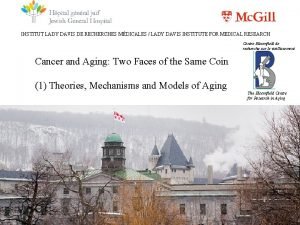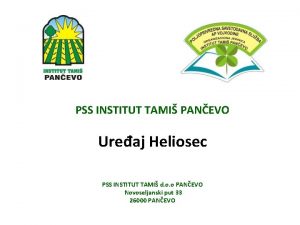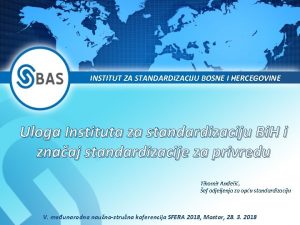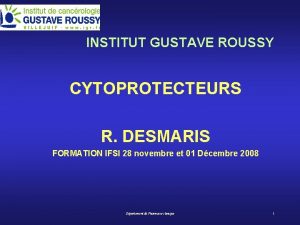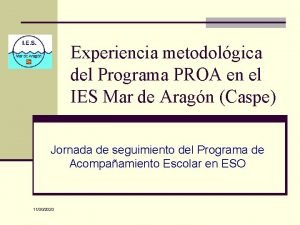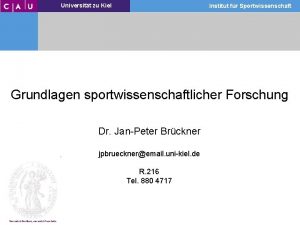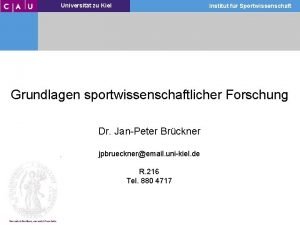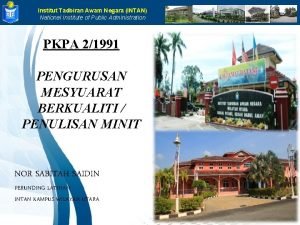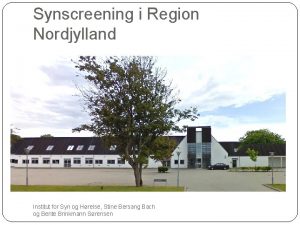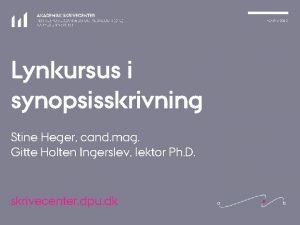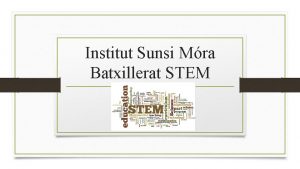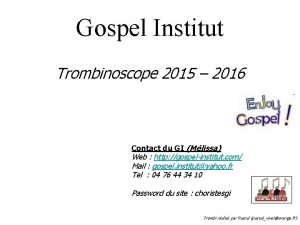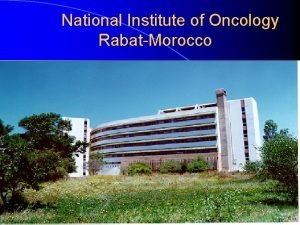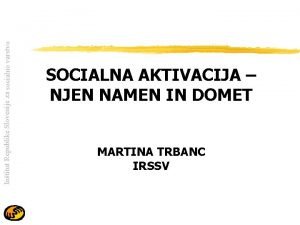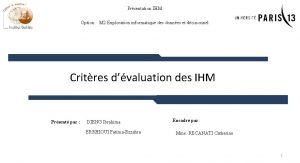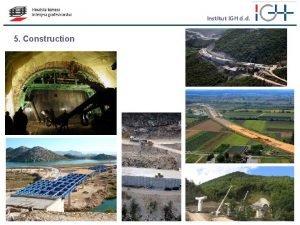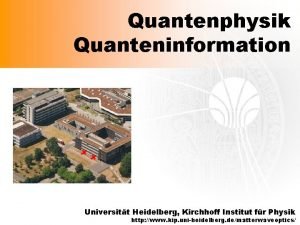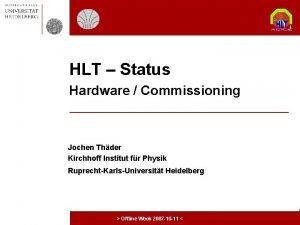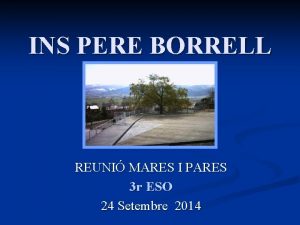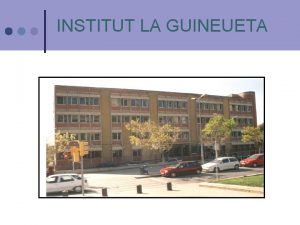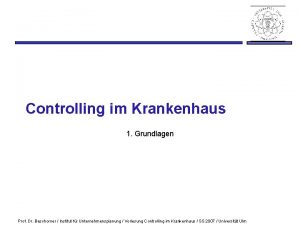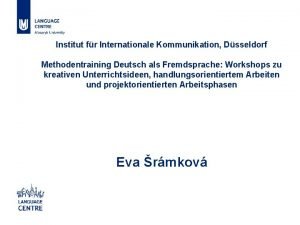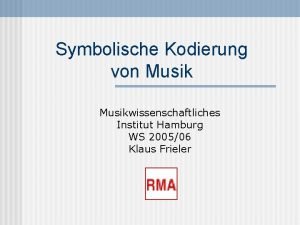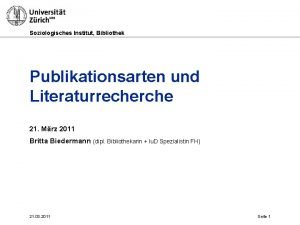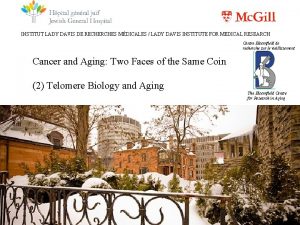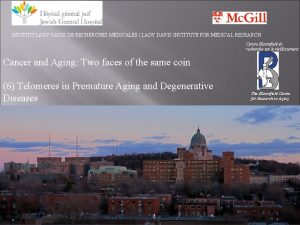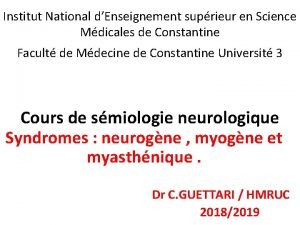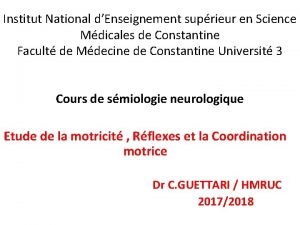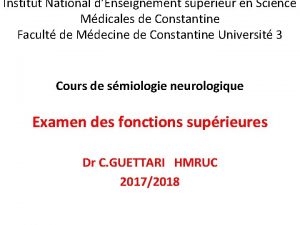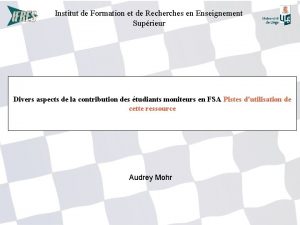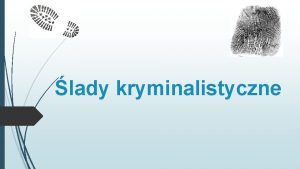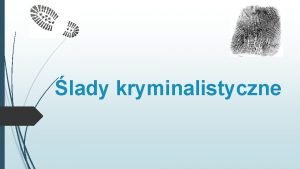INSTITUT LADY DAVIS DE RECHERCHES MDICALES LADY DAVIS



















































- Slides: 51

INSTITUT LADY DAVIS DE RECHERCHES MÉDICALES / LADY DAVIS INSTITUTE FOR MEDICAL RESEARCH Centre Bloomfield de recherche sur le vieillissement Cancer and Aging: Two Faces of the Same Coin (3) Telomere Biology and Cancer-Part 2 The Bloomfield Centre for Research in Aging

INSTITUT LADY DAVIS DE RECHERCHES MÉDICALES / LADY DAVIS INSTITUTE FOR MEDICAL RESEARCH Centre Bloomfield de recherche sur le vieillissement The Bloomfield Centre for Research in Aging Targeting Telomerase and Telomeres: Valid Anti-cancer Strategies? Marie Eve Brault, Johanna Mancini, Hanadi Sleiman, Chantal Autexier

Function of telomeres: cap natural chromosome ends to make them stable structures Murray, JM and Carr, AM Nat. Rev. Mol. Cell Biol. 2008 End-to-end fusions Nuclease degradation Telomere recognized as DNA breaks Activation of DNA damage response Senescence/cell death End of chromosome : Double-strand break: Griffith, JD et al. , Cell 1999

Function of telomeres: to ensure complete DNA replication at chromosome ends via telomerase Blasco, MA, Nat. Chem. Biol. 2007 5’ 5’- GGTTAGGGTTAGGGTTAG CAAUCCCAAUC 3’- CCAAT h. TR 3’ h. TERT Azzalin et al. , 2008

The T-loop structure protects telomeres CA Azzalin and J Lingner, Nature, 2007

Strategies for telomere length maintenance 8590% Harley, C. B. Nat. Reviews Canc. , 2008 Murray, JM and Carr, AM. Nat. Rev. Mol. Cell Biol. 2008 1015%

Why does Telomerase Represent a Good Anti-cancer Target? Universal • 85 -90% all tumors are telomerase positive Critical • Telomerase activity/Telomere maintenance is required for the transformed phenotype Specific • Most normal human somatic cells have no or very low telomerase whereas cancer cells upregulate telomerase expression

Issues to Consider When Targeting Telomerase Function Lag phase • Lag phase between the time telomerase is inhibited and the time telomeres of the cancer cells will have shortened sufficiently to produce detrimental effects on cellular proliferation Drug Resistance • Telomerase inhibitors might result in the emergence of drug-resistant cancer cells (reactivation of telomerase or of the alternative lengthening of telomeres (ALT) pathway) ALT mechanism • Alternative ‘recombination based’ mechanisms for telomere maintenance have been reported in 15% of human cancers.

Telomerase and telomeres as potential targets Catherine Lauzon Inhibition of telomere integrity in combination with chemotherapy Marie Eve Brault , Nahid Golabi and Johanna Mancini Regulation of telomere maintenance by recombination Johanna Mancini and Hanadi Sleiman Characterization of G-quadruplex ligands as telomerase inhibitors and/or disruptors of telomere integrity in cancer cells May Shawi and Raquel Aloyz Inhibition of telomerase in combination with chemotherapy in chronic lymphocytic leukemia

Telomeric recombination as a potential resistance mechanism in response to telomere dysfunction

Targeting the integrity of telomeres versus telomerase Telomerase BIBR 1532 Telomere GRN 163 L Telomere erosion « slow » pathway Sensescence (↑p 16, p 21) Telomere shortening Q-quadruplex ligands ex: Telomestatin Telomere uncapping Rapid pathway ↑ apoptosis ↑ DNA damage response (↑γH 2 AX, 53 BP 1, P-ATM) Displacement of POT 1 and/or TRF 2 Chromosome fusions Specific for cancer cells? Decrease proliferation Decreased tumor growth in vivo Enhance the response to cancer drug treatment Adapted from : Kelland L. Clin. Cancer. Res. , 2007 Harley, C. B. Nat. Reviews Canc. , 2008 Murray, JM and Carr, AM Nat. Rev. Mol. Cell Biol. 2008

Telomere disturbance through the expression of a telomerase RNA with a point mutation in the template region (Mu. A-h. TR) Telomerase-based anti-cancer approach: Wild-Type telomerase RNA template 5’-CUAACCCUAA-3’ specifies TTAGGG repeats 5’ -GGTTAGGGTTAGGGTTAGG G T T A G G G T T AG 3’ -CCAAT Mutant telomerase RNA template 5’-CAAACCCAAA-3’ specifies TTTGGG repeats 5’ -GGTTAGGGTTAGGGTTAGG G T T T G 3’ -CCAAT -Tumor specific (telomerase-dependent) - No lag phase - General

Anticancer strategies targeting telomere function by expression of template-mutated h. TR • Growth inhibition • Altered cell cycle • Apoptosis • Senescence • No effect on telomerase-negative lung fibroblasts • Loss of tumor growth in xenografts • Dependent on assembly of an active enzyme • DNA damage response at telomeres • Chromosome fusions • Anaphase bridges • Independent of p 53 status • Can be ATM dependent Marusic L. et al. (1997) Mol. Cell. Biol. 17: 6394 -6401; Guiducci, C. et al. (2001) Oncogene 20: 714 -725; Kim MM. et al. (2001) Proc. Natl. Acad. Sci. 98: 7982 -7987; Li S. et al. (2004) Cancer Res. 64: 4833 -4840; Goldkorn, A. and Blackburn, E. H. (2006) Cancer Res. 66: 5763 -5771; Cerone, MA et al. (2006) Oncogene 25: 7411 -7420; Stohr, B. A. and Blackburn, E. H. (2008)Cancer Res. 68: 5309 -5317; Mahalingam, D. et al. (2011) FEBS J. 278, 3724 -3738.

Generation of cancer cell lines with various telomere lengths expressing template-mutated h. TR YCC-B 1 Telomere length (kb) 3. 2 (short) Telomerase + YCC-B 2 11 (long) + MCF-7 7 (intermediate) + GM 847 >20 (ALT) - Determine effects on cell viability and proliferation upon treatment with chemotherapeutic drugs Cerone, M. A. , Londoño-Vallejo, J. A. and Autexier, C. 2006 Mutated telomeres sensitize tumor cells to anticancer drugs independently of telomere shortening and mechanisms of telomere maintenance. Oncogene 25, 2411 -2420.

Mu. A-h. TR has a mild effect on cell viability and proliferative ability Cerone, M. A. , Londoño-Vallejo, J. A. and Autexier, C. Oncogene, 2006.

Mu. A-h. TR expression increases the sensitivity of cancer cells to chemotherapeutic drugs independently of telomere length and initial telomerase status YCC-B 1 (short TRF) Relative number of colonies YCC-B 2 (long TRF) vector Mu. Acl 1 Mu. Acl 4 ** *** Mu. Acl 17 Mu. Acl 23 Mu. Acl 27 **p<0. 01; ***p<0. 0001 MCF-7 (intermediate TRF) Relative number of colonies GM 847 (ALT) * *** vector h. TERTcl 1 **p<0. 01; ***p<0. 0001 *** vector Mu. Acl 1 *** ** Mu. Acl 6 **p<0. 01; ***p<0. 0001 vector ** *** Mu. Acl 6 Mu. Acl 12 cl 5 cl 16 h. TERT+Mu. A-h. TR *p<0. 05; ***p<0. 001 Cerone, M. A. , Londoño-Vallejo, J. A. and Autexier, C. Oncogene, 2006.

Mu. A-h. TR expression alters the cell cycle profile of YCC-B 2 cells after drug treatment perhaps leading to the increased sensitization to drugs G 1/G 2 -M ratio Cell cycle distribution * vector * * Mu. Acl 17 Mu. Acl 23 Mu. Acl 27 Sub. G 1 fraction vector Mu. Acl 17 Mu. Acl 23 ** Mu. Acl 27 vector Cerone, M. A. , Londoño-Vallejo, J. A. and Autexier, C. Oncogene, 2006. Mu. Acl 17 * Mu. Acl 23 ** Mu. Acl 27

DNA damage response at the telomeres : Telomere Dysfunction-Induced Foci (TIFs) Telomere dysfunction induced-foci (TIFs) CA Azzalin and J Lingner, Nature, 2007 53 BP 1 γH 2 AX p-ATM MRN MDC 1

Mu. A-h. TR induces the formation of TIFs containing TRF 1 and 53 BP 1 in YCC-B 2 cells Brault and Autexier, MBC, 2011

Mu. A-h. TR induces the formation of TIFs containing TRF 1 and P-ATM Ser 1981 in YCC-B 2 cells Brault and Autexier, MBC, 2011

Observed a broader distribution of relative telomere lengths within cells carrying the mutant RNA, suggesting possible telomeric recombination events vector Mu. A cl 23 Mu. A cl 17 Mu. A cl 27 Cerone, M. A. , Londoño-Vallejo, J. A. and Autexier, C. Oncogene, 2006.

Characteristics of ALT cells Homologous recombination (HR) mediated events leading to: 1. exceptionally long and heterogeneous telomeres, ranging from <2 kb to >50 kb 2. High levels of telomeric sister chromatid exchange (T-SCE) 3. Altered pq-ratios 4. extrachromosomal telomeric DNA, of circular (termed t-circles) forms ALT-associated promyelocytic leukemia bodies (APBs) which may be the sites of recombination

The telomeres in ALT cells are highly heterogeneous and extremely long

Measuring Telomere-Sister Chromatid Exchanges (T-SCEs) : the CO-FISH Technique Palm, W. and de Lange, T. Annu. Rev. Genet. 2008.

Increased frequency of T-SCEs in the YCC-B 2 cells after Mu. A-h. TR expression Brault and Autexier, MBC, 2011

Changes in pq-ratios indicate telomeric recombination Cell divisions No recombination Ratio q/p = 3/3 Ratio q/p = 2/2 Ratio q/p = 2/4 Ratio q/p = 1/1 Ratio q/p = 2/5 Ratio q/p is constant Ratio q/p changes

Mutant telomerase RNA expression is associated with changes in telomere pq-ratios Brault and Autexier, MBC, 2011

Mutant telomerase RNA expression is associated with changes in telomere pq-ratios Brault and Autexier, MBC, 2011

Mu. A-h. TR expression results in the accumulation of circular extrachromosomal telomeric DNA Palm, W. and de Lange, T. Annu. Rev. Genet. 2008. Brault and Autexier, MBC, 2011

ALT cells contain a high level of ALT associated promyelocytic leukemia bodies (APBs) Irena Draskovic et al. , PNAS, 2009. Murray, JM and Carr, AM. Nat. Rev. Mol. Cell Biol. 2008

Increased formation of PML bodies associated with telomeric DNA in telomerase-positive cells expressing mutant telomerase RNA Brault and Autexier, MBC, 2011

Telomeric recombination induced by dysfunctional telomeres – Elevated DNA damage response located at the telomeres (Telomere dysfunction-induced foci), suggesting that the incorporation of mutant repeats disturbs the telomere cap – Increased frequency of Telomere Sister Chromatid Exchange (T-SCEs), elevated pq-ratios and extrachromosomal telomeric DNA fragments were observed in the Mu. A-expressing cells, which are consequences of homologous recombination between telomeres – First report of telomere dysfunction inducing telomeric recombination in mammalian cells without telomerase inhibition and of endogenous telomerase and telomeric recombination pathways coexisting spontaneously in cancer cells Conclusion Our results suggest that after telomere destabilization, there is a strong selection pressure for the emergence of resistant cells with increased telomeric recombination and telomeric recombination could be a potential resistance mechanism in response to telomere dysfunction However, the use of chemotherapeutic drugs decreases the proliferation of the Mu. A-expressing cells, despite the presence of a recombinationbased mechanism for telomere maintenance

Model Telomere maintenance independent of telomerase and survival MRN Rad 52 ↓proliferation ↑apoptosis HR proteins favors telomere recombination rather than Tloop formation ↑instability TRF 1, TRF 2 and POT 1 cannot bind to mutant sequences Drugs

Perspective The factors involved in resistance to induced-telomere dysfunction could include the impaired p 53 status of YCC-B 2 and additional proteins which regulate or may regulate ALT or telomeric recombination Ku 70 Pot 1 SMC 5/6 p 53? Protected telomeres Mutant telomerase RNA Uncapped telomeres Apoptosis Senescence p 53 status Additional mutations? Shelterin HR HR proteins Telomeric recombination Cancer resistance Adapted from Brault and Autexier, Cell Cycle, 2011 ? Adapted from De Boeck, G. et al. J. of Path. 2008.

Inhibiting telomerase and telomere function in cancer cells with G-quadruplex ligands

G-quartet • Bang 1910 • Gellert et al 1962 • 4 Guanines • Stabilized by Hoogsteen Hydrogen bonds • Stacked = G-quadruplex • Stabilized by K + and Na+ Balasubramanian et al Nature Reviews Drug Discovery (2011)

G-quadruplex • Forms determined by: – Strand number • Monomer, Dimer, Tetramer – Strand direction • Parallel, anti-parallel – Loops • Lateral/Edgewise • Diagonal • Chain-reversal/Propeller – D, E, & F formed in human telomeric repeats Unimolecular Parallel Propeller Unimolecular Anti/Parallel Diagonal Huppert Unimolecular 1 Anti/3 Parallel J. Chem Soc Rev (2008)

Location of G-quadruplexes • Genome-wide sequence analysis identified 376 000 putative sequences (not homogenously distributed) • Within the nucleus: a) promoter region of genes b) during replication c) telomeric 3’ G-overhangs • Outside of nucleus: d) 5’ UTR of m. RNA Lipps & Rhodes. Trends in Cell Biology (2009)

G-Quadruplex Stabilization Leads to Telomerase Repression 3’ G G G G G G G G G 5’ 5’ G G G Adapted from Fakhoury, J, Nimmo, G, Autexier, C. Anticancer Agents in Medicinal Chemistry, 2007 3’

Phenotypes elicited by G-quadruplex ligands • Telomerase inhibition • Telomere shortening • Lag phase dependent antiproliferative response in cancer cells • Rapid telomere shortening-independent antiproliferative effects • Loss of the G-rich overhang • Dissociation of TRF 2 and Pot 1 from the telomere • Increased DNA damage foci at telomeres • Activation of DNA damage response • Apoptosis • Antitumor activity in mouse tumor models • Antiproliferative response restricted to cancer cells Reviewed in De Cian, A. et al. Biochimie, 2008.

Transition metal-based Gquadruplex binders Many advantages to implementing metals: Modular/tunable Multiple metal geometries/inherent positive charge Ease of synthesis Potential reduction in overall synthetic time Neidle, Vilar, JACS 2006, 128, 5992 Meunier, JACS 2007, 129, 1502 Haq, Thomas, JACS 2006, 12, 4611

Platinum phenanthroimidazoles as G-quadruplex binders Challenge: Make DNA binders selective for G-quadruplexes using square planar transition metals to extend the π-surface R. Kieltyka, Fakhoury J. , Moitessier N. , Sleiman H. , Chem. Eur. J. , 2008, 14, 1055.

Q-quadruplex Ligands BPY PIP PIN PII PIQ SIP CLIP Pt. Naphtylphenanthroimidazole based complexes withethylenediamine extended ethylenediamine surfaces afford greater binding Quinolinylphenanthroimidazole Indolylphenanthroimidazole Phenylphenanthroimidazole Salicylphenanthroimidazole p-chlorophenylphenanthroimidazole Bipyridine ethylenediamine platinum(II) platinum(II) affinity and selectivity platinum(II) to G-quadruplex over duplex DNA New class. Quinoline Less with. Parent πattached Introduce extended NReduced complex actsaryl Naphtyl as phenol substituent, H-bond binding withbut acting Phenyl acceptor –lowered Negative as preventing -H-donor increase to binding imidazole control to twist πaffinity imidazole surface through N-donor NH-bonding Bigger Less selectivity surface Increased increased – closest bindingto stacking affinity PIP but and but with selectivity introduced better affinity twist Added a Halogen, shifting electron density towards Cl Increased binding affinity and selectivity

Ligand Binding Affinity & Selectivity • Binding Affinity assessed by FID fluorescence intercalator displacement assay • Compared to 17 mer & 26 mer PIP PIN PII PIQ SIP CLIP BPY • Binding affinity measured by ds. DC 50/G 4 DC 50 concentration of cmplx req to give 50% decrease in fluorescence Castor K et al. Chem. Med. Chem (2012)

In vitro Telomerase Inhibition 100 + 20 - 4 PII (µM) 0. 8 PIP (µM) 0. 16 PIN (µM) 0. 032 BPY (µM) bp 100 75 50 35 100 20 0. 8 + 4 - 0. 16 bp 0. 032 100 CLIP (µM) 20 4 + 0. 8 - 0. 16 bp 0. 032 100 SIP (µM) 20 4 0. 8 + 0. 16 - 0. 032 PIQ (µM) 100 75 75 75 35 50 35 TRAP-Lig IC 50 (μM) BPY ND PIP 0. 46 ± 0. 29 PIN 6. 81 ± 5. 84 PII 0. 93 ± 1. 78 PIQ 2. 48 ± 1. 49 SIP 11. 6 ± 1. 78 CLIP 5. 71 ± 1. 55 BRACO-19 6. 30 bp 100 50 Ligand 50 35 0. 60 Telomestatin Castor K et al. Chem Eur J (2011) Submitted

Short term cytotoxicity assay suggest cancer cell specific effects MTS (72 h) – Proliferation Cell Type Cancer Telomerase + Cancer, ALT Telomerase Normal Primary MTS: Metabolic activity assay IC 50 Cell Line BPY (µM) PIP (µM) CLIP (µM) A 549 N/A 21. 91 ± 1. 20 13. 41 ± 1. 23 HUH 7 N/A 11. 45 ± 1. 09 16. 70 ± 1. 14 MCF 7 N/A 42. 91 ± 1. 17 18. 37 ± 1. 11 GM 847 N/A 27. 73 ± 1. 04 9. 33 ± 1. 02 MRC-5 N/A 50. 00 57. 61 ± 2. 85 WI-38 N/A 70. 85 53. 63

Cell Studies: Experimental Design 1 x 105 cells + Cpd [1 X, 0. 5 X, 0. 1 X IC 50] 1 x 105 cells 1) Seeding 2) Promoter D 1 D 4, D 8, D 11, D 15, D 18, D 22, etc 1 x 105 cells + Cpd [1 X, 0. 5 X, 0. 1 X IC 50] D 4, D 8, D 11, D 15, D 18, D 22, etc

Cell Studies: Seeding Experiment

Cell Studies: q. PCR • c-myc – most studied G 4 forming promoter region – upregulated in many cancers – is a regulator of h. TERT • h. TERT – forms 2 different G 4 in the promoter region – expression is required for telomerase activity

Conclusions and perspectives • Molecules with distinct structural features that target G-quadruplex can be generated using supramolecular self-assembly • phenanthroimidazole platinum(II) complexes are G-quadruplex stabilizers and telomerase inhibitors • We will further evaluate improved ligands with increase binding affinity and selectivity to the G-quadruplex substrate (telomeric or promoter) • Ligands are currently being tested for cancer cell specific antiproliferative effects • Mechanism of action to be determined: telomere length dependent or independent, effect on G-quadruplex containing promoters relevant to telomerase (c-myc, h. TERT) • Best molecule will be tested for antitumor activity in xenograft mouse model

Acknowledgements Collaborators and Colleagues Hanadi Sleiman José-Arturo Londoño-Vallejo Sun Young Rha Titia de Lange Lab members Shusen Zhu Yasmin D’Souza Marie-Eve Brault May Shawi Catherine Lauzon Sanjida Khondaker Johanna Mancini Josephine Chu Nahid Golabi Ricky Kwan Alumni Maria A. Cerone Johans Fakhoury
 Contrave ramq
Contrave ramq Institut lady davis
Institut lady davis Datalogisk institut aarhus
Datalogisk institut aarhus Ins torre de malla
Ins torre de malla Pss institut tamiš pančevo
Pss institut tamiš pančevo Klips2 uni köln login
Klips2 uni köln login Institut za standardizaciju bih
Institut za standardizaciju bih Formation gustave roussy
Formation gustave roussy Gestin institut roquetes
Gestin institut roquetes Institut fontaine croix
Institut fontaine croix Uni kiel sportwissenschaft
Uni kiel sportwissenschaft Institut des réviseurs d'entreprises
Institut des réviseurs d'entreprises Institut national des sciences appliquees de lyon founded
Institut national des sciences appliquees de lyon founded Moggis vsaps
Moggis vsaps Gestin institut roquetes
Gestin institut roquetes Uzh soziologisches institut bibliothek
Uzh soziologisches institut bibliothek Institut joan segura i valls
Institut joan segura i valls Institut für sportwissenschaft kiel
Institut für sportwissenschaft kiel Bina ayat institut tadbiran awam negara
Bina ayat institut tadbiran awam negara Institut za hrvatski jezik i jezikoslovlje
Institut za hrvatski jezik i jezikoslovlje Gestin institut roquetes
Gestin institut roquetes Institut giola moodle
Institut giola moodle Sundheds og kulturforvaltningen aalborg
Sundheds og kulturforvaltningen aalborg Institut de formation doctorale
Institut de formation doctorale Institut for uddannelse og pædagogik
Institut for uddannelse og pædagogik Institut sunsi mora
Institut sunsi mora Gospel institut grenoble
Gospel institut grenoble Institut national d'oncologie rabat
Institut national d'oncologie rabat Irssv
Irssv Iescanet aula virtual
Iescanet aula virtual Institut galilée
Institut galilée Institut igh d.d.
Institut igh d.d. Kip heidelberg
Kip heidelberg Kirchhoff institut für physik
Kirchhoff institut für physik Sib schweizerisches institut für betriebsökonomie
Sib schweizerisches institut für betriebsökonomie Institut pere borrell
Institut pere borrell Gradski zavod za javno zdravlje beograd
Gradski zavod za javno zdravlje beograd Max planck institut rechtsgeschichte
Max planck institut rechtsgeschichte Gestin institut roquetes
Gestin institut roquetes Institut za javno zdravlje kragujevac
Institut za javno zdravlje kragujevac Mydars institut
Mydars institut Institut la guineueta
Institut la guineueta Operatives controlling krankenhaus
Operatives controlling krankenhaus Institut für hauswirtschaft
Institut für hauswirtschaft Terres de ponent mollerussa
Terres de ponent mollerussa Musikwissenschaftliches institut hamburg
Musikwissenschaftliches institut hamburg Diskriminanzanalyse
Diskriminanzanalyse Ifak institut gmbh & co. kg
Ifak institut gmbh & co. kg Institut pertanian intan yogyakarta
Institut pertanian intan yogyakarta Rechtsmedizin essen
Rechtsmedizin essen Icqp cataleg
Icqp cataleg Publikationsarten
Publikationsarten

